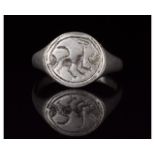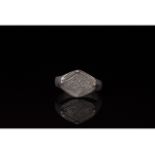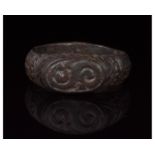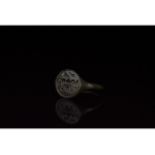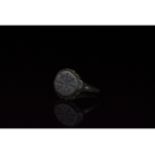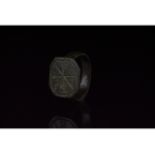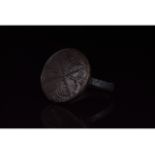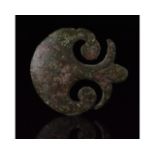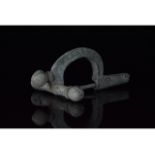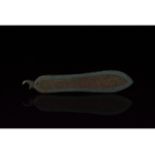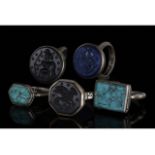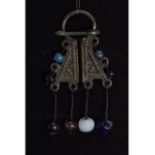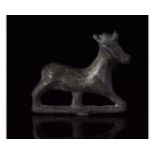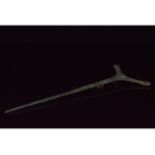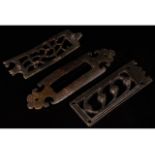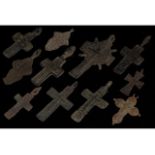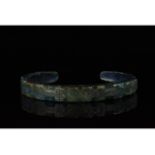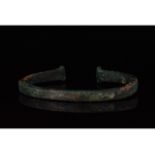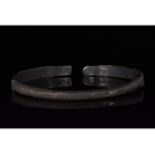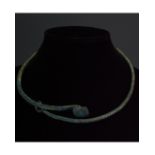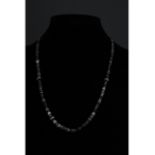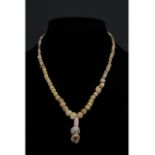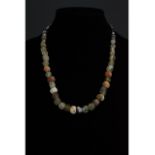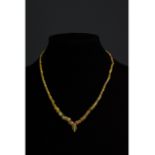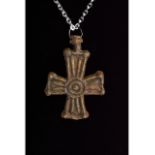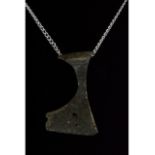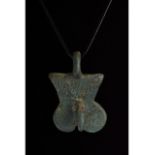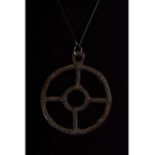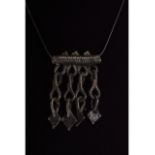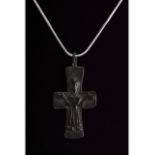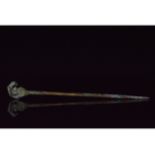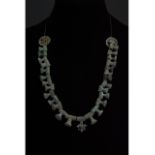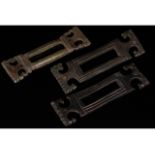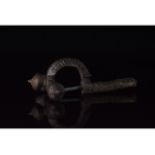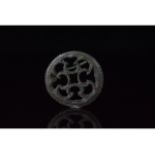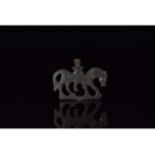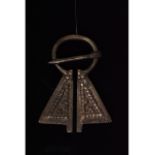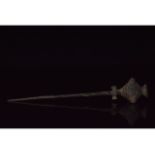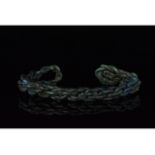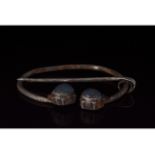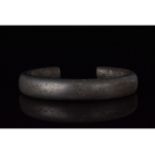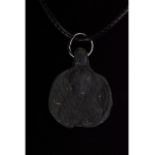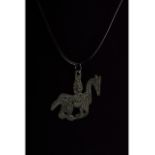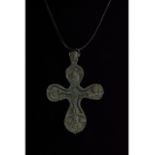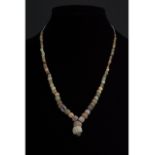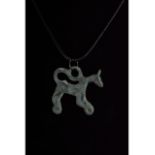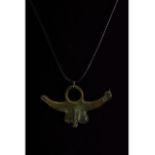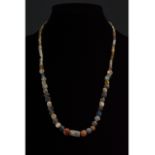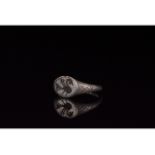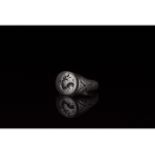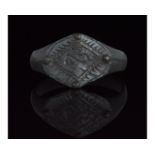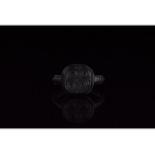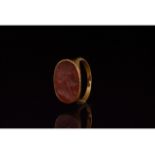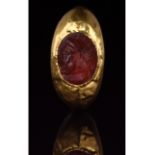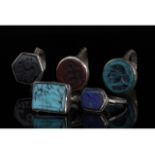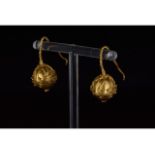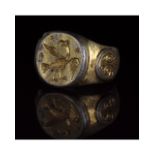Refine your search
Estimate
Category
- Arms, Armour & Militaria (123)
- Jewellery (85)
- Greek, Roman, Egyptian & Other Antiquities (43)
- Sculpture (26)
- Collectables (21)
- Glassware (16)
- Ceramics (5)
- Coins (5)
- Metalware (5)
- Chinese Works of Art (4)
- Vintage Fashion (4)
- Textiles (3)
- Wines & Spirits (3)
- Islamic Works of Art (2)
- Musical Instruments & Memorabilia (2)
- Salvage & Architectural Antiques (2)
- Taxidermy & Natural History (2)
- Tools (2)
- Lighting (1)
- Models, Toys, Dolls & Games (1)
- Scientific Instruments (1)
Filtered by:
- Item Type
- List
- Grid
A subscription to the Price Guide is required to view results for auctions ten days or older. Click here for more information
700-1100 AD, Viking Age. A silver ring with D-shaped hoop and flattened, circular bezel bearing an incised depiction of a stylised wolf within a c...
C. 700-1100 AD, Viking Age. A silver ring with a D-shaped hoop, a lozenge-shaped bezel with incised linear and curvilinear decorations, possibly r...
c. 1-300 AD. Roman. A heavy bronze ring with a D-shaped hoop, a round bezel with incised curvilinear decoration probably representing a lituus, a ...
1-200 AD. Roman. Bronze ring with D-shaped hoop and flattened, circular bezel bearing an incised eagle motif. An aquila (eagle) was a prominent sy...
1000-1500 AD, Crusader Period. Bronze ring with D-shaped hoop, and elliptical bezel with petalled border and incised motif comprising a large cros...
1000-1500 AD, Crusader Period. A bronze ring with a D-shaped hoop and flat, hexagonal bezel bearing a rare incised arrow and key motif. The Crusad...
900-1000 AD, Byzantine. A large Byzantine bronze ring with a D-shaped hoop, and trumpet bezel bearing an incised a floral pattern which forms a cr...
C. 100-300 AD. Roman. Bronze scabbard chape (or bottom) with pelta-shaped body surmounted by a stylised budding flower motif. Chapes serve to rein...
300-400 AD. Late Roman. An excellent bronze crossbow brooch, with three onion-like protrusions, an arched bow, rectangular tail and surviving pin....
100-200 AD. Roman. Bronze brooch in the shape of a sandal, with traces of enamelling on the obverse and a well-preserved pin and catch-plate on th...
Ca.1700-1950 AD. Yemeni Tribal. Lot of five white metal Yemeni Tribal intaglio rings with turquoise and blue coloured stone itaglio settings some ...
Ca. 900-1100 AD. Viking Era. A late Viking era pannanular omega brooch with flaring terminals decorated with raised dots arranged in geometric pat...
ROMAN BRONZE STAG BROOCH
1-200 AD. Roman. A well-preserved zoomorphic brooch depicting running a bull in profile, with a well-preserved pin and catch-late on the reverse. ...
C. 700-1100 AD. Viking Age. Large bronze cloak pin with branching head, raised decorative ribs near the top and an attachment loop on the reverse....
1-300 AD. Roman. Three elongated openwork Roman legionary belt plates with vegetal motifs. Belt sets were important parts of Roman military unifor...
C. 1200 - 1800 AD. Medieval and post-Medieval. A beautiful collection of 10 cross pendants including bronze and iron examples, all of which are ca...
700-1100 AD, Viking Age. A heavy bronze bracelet with punched dot and box decoration, and incised lines on the terminals thought to be a stylised ...
ROMAN BRONZE ARMILLA BRACELET
C. 1-300 AD. Roman. A heavy bronze armilla bracelet with rectangular section and sub-square flattened terminals. Armillae were armband style brace...
700-1100 AD, Viking Age. Beautiful silver bracelet with elongated terminals which feature two grooves ornamented with a ‘scale’ pattern and end in...
C. 900-1100 AD. Viking Period. This beautiful bronze torc has a twisted design, with its terminals fashioned into a loop and flattened, angled squ...
ROMAN AGATE BEADED NECKLACE
Ca. 1-300 AD. Roman. A restrung necklace of Roman beads comprising beautiful semiprecious blue, grey and black Roman agate beads. The agate beads ...
ROMAN/PARTHIAN BEADED NECKLACE
Ca. 1-300 AD. Roman/Parthian. A restrung necklace of Roman beads comprising beautiful stone, glass and glasspaste beads in creamy yellow hues in a...
BEAUTIFUL ROMAN BEADED NECKLACE
Ca. 1-300 AD. Roman. A restrung necklace of Roman beads comprising multiple opaque and transparent sub-spherical, tubular, cubical and lentoid gla...
BEAUTIFUL ROMAN BEADED NECKLACE
Ca. 1-300 AD. Roman. A restrung necklace of Roman beads comprising multiple opaque and transparent sub- spherical, tubular and rhomboidal glass, g...
Ca. 1-300 AD. Roman. A restrung necklace of Roman beads comprising multiple transparent sub- spherical, tubular and discoid and lentoid glass, bea...
CRUSADERS ERA LEAD PILGRIM CROSS
C. 1000-1500. Crusader period. Lead cross with suspension loop and four ribbed arms arranged around a central rondel. The Cross, the principal sym...
700-1100 AD, Viking Age. A bronze example of an axe or Perun amulet comprising a suspension loop and a stylised axe with a notched head, and inpre...
c. 1-300 AD. Roman. A spectacular bronze pendant comprising a phallus, testes, and pubic mound which is decorated with incised lines meant to simu...
BRONZE AGE SUN AMULET
C. 600 BC, Bronze Age European. Openwork bronze sun pendant comprising two concentric circles with raised decorative dots at regular intervals joi...
c. 900-1100 AD. Viking age. A beautiful bronze dragon’s foot amulet comprised of four stylised feet each comprising three applied spheroid decorat...
1000-1500 AD, Medieval Crusader period. Bronze crucifix pendant comprising four flat arms, with squared off terminals bearing an image of Jesus be...
800 BC Bronze age pin with stylised beast termonal; good cindition. Size: 200 mm/ 50 grams. Provenance: Private UK collection; acquired in the 198...
Ca.800 - 600 BC. Celtic Late Bronze Age / Early Iron Age – Druidic. A bronze necklace formed of numerous stylised mace-head pendant beads. Such ne...
1-300 AD. Roman. Three elongated openwork Roman legionary belt plates with scalloped edges. Belt sets were important parts of Roman military unifo...
300-400 AD. Late Roman. An excellent bronze crossbow brooch, with three onion-like protrusions, an arched bow, rectangular tail and surviving pin....
ROMAN OPEN-WORK PLATE BROOCH
100-200 AD. Roman. Bronze disk brooch with openwork decoration forming abstract geometric patterns and a well-preserved pin and catch-plate on the...
100-200 AD. Roman. Bronze horse and rider brooch, depicting a human rider, probably male, on horseback, shown in profile. The catch-plate is parti...
VIKING AGE SILVER OMEGA BROOCH
Ca. 700-1100 AD. Viking Era. A Viking era silber omega brooch with flaring terminals decorated with raised dots arranged and incised lines, circul...
BRONZE AGE LURISTAN CLOTH PIN
Ca.1300-600 BC. Bronze Age Luristani culture. Bronze cloth pin comprising a round-sectioned shank and stylised poppy-head finial. Good condition; ...
VIKING BRONZE TWISTED BRACELET
700-1100 AD, Viking Age. A heavy silver twisted bracelet comprised strands of silver woven together, with looped terminals meant evoke the form of...
Ca. 700- 1100 AD. Viking Era. A fine Viking era silver 'Omega' penannular brooch with hemi-spherical blue gems set into the terminals terminals, a...
HEAVY BRONZE AGE BRACELET
1000 – 600 BC, Bronze Age. This thick and heavy cast bronze bracelet features a D-shaped section. In the Bronze Age bracelets were used not only a...
C. 1200 AD. Byzantine. Bronze medallion for wear as an amulet, depicting an angel shown in a hieratic (frontal) posture. Such medallions were comm...
RARE VIKING ODIN ON HORSE AMULET
700-1100 AD, Viking Age. Rare bronze amulet depicting a highly stylised rider, Odin, on horseback; a suspension loop protrudes from Odin’s head. O...
1000-1500 AD, Medieval Crusader period. A large bronze cross pendant comprising four rounded arms adorned with incised decoration. The Cross, the ...
ROMAN BEADED NECKLACE
Ca. 1-300 AD. Roman. A restrung necklace of Roman beads comprising multiple opaque and transparent sub- spherical, tubular and discoid, and melon-...
VIKING BEAST BRONZE AMULET
700-1100 AD, Viking Age. Bronze pendant showing a horned, winged beast, probably a dragon, in profile. In Norse mythology, Fáfnir (Old Norse and I...
ROMAN BRONZE PHALLIC AMULET
c. 1-300 AD. Roman. A large bronze pendant comprising a phallus, testes and pubic mound, flanked by two protruding arms, one in the shape of a pha...
SUPERB ROMAN BEADED NECKLACE
Ca. 1-300 AD. Roman. A restrung necklace of Roman beads comprising multiple opaque and transparent sub- spherical, tubular and discoid glass, glas...
700-1100 AD. Viking Age. A silver ring with D-shaped hoop with incised hatching decoration on the shoulders, and flattened, elliptical bezel beari...
c. 1000-1100 AD. Viking age. A beautiful silver ring with a circular hoop and round bezel bearing incised decoration in the form of a dragon, prob...
C. 700-1100 AD, Viking Age. A bronze ring with a D-shaped hoop, a lozenge-shaped bezel with incised linear and curvilinear decorations, possibly r...
ca.600-800AD, Saxon period. Striking bronze ring with thin circular hoop decorated with incised lines and thick octagonal bezel featuring four set...
c. 198-217 AD. Roman. Rare gold ring with circular hoop and elliptical trumpet bezel with red stone intaglio (probably carnelian), which depicts t...
1-300 AD, Roman. Gold ring with D-shaped hoop, and an elliptical bezel with a red gem intaglio bearing a bust of Sol Invictus wearing a radiate cr...
Ca.1700-1950 AD. Yemeni Tribal. Lot of five white metal Yemeni Tribal intaglio rings with turquoise, blue, black and deep red coloured stone intag...
C. 1-300 AD, Roman. Pair of gold bauble earrings comprising globuled decorated with round granulations surounded by trailed gold threads to create...
1100-1500 AD. Medieval. Large silver gilt ring with D-shaped hoop, with applied shields containing wing motifs on each shoulder, and flat, circula...
700-1100 AD, Viking Age. Silver ring with a circular hoop, and a lozenge shaped bezel onto which is mounted a large, circular black gem. This simp...
Ca.400 AD. Late Romano-Jewish. Beautiful rare gold cameo pendant comprising a sub-oval gold pendant (possibly later) with roped gold decoration at...

